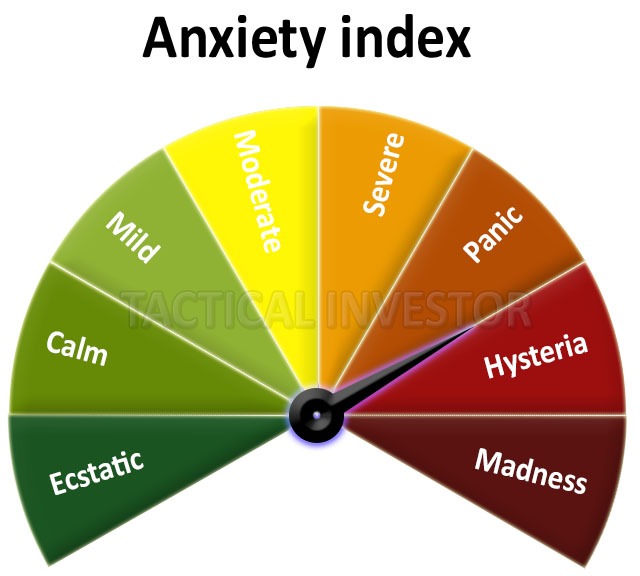Stock Market Fear Index & Murphy’s Law: A Call to Arms
Feb 7, 2025
In the battlefield of financial markets, where bullish euphoria and bearish despair collide, investors often ride the unpredictable waves of volatility. It’s easy to fall prey to the maxim of Murphy’s Law—”Anything that can go wrong will go wrong.” Yet, this piece of conventional wisdom only scratches the surface. Dig deeper, and you’ll uncover timeless strategies from ancient minds that not only survived but thrived amidst the chaos, offering lessons on resilience, foresight, and the art of managing risk with elegance.
Thales of Miletus: The Strategist Who Bet on Patience
Thales didn’t just observe the market—he mastered it. Over two millennia ago, this Greek philosopher turned financial strategist made history by using options bullish euphoria in olive presses, a concept now considered a cornerstone of modern finance. Thales believed, “The most difficult thing in life is to know yourself.” Translated into today’s terms: know your risk and strategy, and never let the market dictate your moves. In an era dominated by impulsive traders chasing the highs and lows of fleeting trends, Thales’s wisdom stands as a call to arms for investors to craft a strategy rooted in clarity and patience, unshaken by market whims.
Kuan Chung: The Silent Conqueror of Economic Warfare
Kuan Chung, the shrewd strategist from ancient China, knew how to dominate without drawing attention. His philosophy? “To plan secretly, to move surreptitiously, to foil the enemy’s intentions and baulk his schemes so that the day may be won without shedding a drop of blood.” He didn’t rush into battle; he bided his time, knowing the value of strategic patience and subtlety. In the modern market, his approach resonates: think three steps ahead, understand your opponent (the market), and avoid rash decisions fueled by fear. In short, invest like a chess master—calculated, precise, and always thinking ahead.
The Discipline of True Risk Management: Navigating the Storm with Authority
In the volatile stock market, the disciplined investor remains unshaken. Investors who achieve success are those who refuse to bend to the whims of market sentiment, staying the course with a clear, unyielding strategy. It’s not about chasing the latest trend—it’s about crafting a strategy that is as steadfast as it is informed, one that is as resilient in a bear market as it is in a bull run.
Building Your Unbreakable Investment Strategy
To weather the storms, you must first build your fortress. This means creating a strategy with unwavering resolve—an investment blueprint that withstands market tempests and sidesteps the seduction of reckless speculation. Warren Buffett’s words ring true: “Risk comes from not knowing what you’re doing.” This isn’t just about avoiding losses; it’s about taking control of your financial destiny by aligning your investments with your true goals. Know your risk tolerance and craft a strategy that reflects who you are, not who the market tells you to be.
Mastering Your Risk Profile: The Power of Knowing Yourself
Your risk profile isn’t just a number—it’s the foundation upon which your strategy is built. Do you prefer the safety of steady returns, or do you hunger for higher stakes and greater rewards? Identifying this will allow you to choose investments that match your objectives. Whether it’s the stability of bonds or the adrenaline of stocks, understanding where you stand will enable you to invest with purpose and precision, never driven by the market’s unpredictable mood swings.
Defeat Murphy’s Law: Accurately Assess Your Risk Profile
Once your risk profile is established, the next critical step is to create a well-diversified investment portfolio. Diversification is a key risk management strategy, helping minimize the impact of market fluctuations and reduce the overall risk of loss. By spreading investments across various asset classes, sectors, and geographic regions, you can buffer your portfolio against market volatility and enhance the likelihood of achieving your investment goals.
Creating a Diversified Investment Portfolio**: Benjamin Graham’s wisdom highlights the importance of diversification, noting that “The individual investor should act consistently as an investor and not as a speculator.” This means focusing on a diversified portfolio that can withstand market ups and downs rather than attempting to time the market or chase potential high returns through speculative bets.
Tactical Investor Stock Market Fear Index

The Hysteria Zone: A Sign of a Long-Term Market Bottom?
When the anxiety index (shown above) approaches the hysteria zone, it often signals a potential long-term market bottom. However, as many financial experts advise, it’s crucial to remember that no single tool or indicator should be relied upon in isolation. Integrating the stock market fear index with other analytical tools can provide a more comprehensive view, aiding investors in determining optimal entry and exit points.
Utilizing Multiple Indicators: As Benjamin Graham once suggested, the intelligent investor must consider the apparent market conditions and delve deeper into various indicators to make informed decisions. This approach helps mitigate the risks associated with emotional investing, which can often cloud judgment.
Stock Market Fear Index Conclusion
As the market enters a bullish phase and indicators point towards an “overbought zone,” adjustments in the cash requirements for those in the low—to medium-risk categories might be necessary. This strategic shift is essential to managing risk effectively and sidestepping potential pitfalls. Adapting risk profiles based on market trends can inadvertently lead to speculative behaviours, which more closely resemble gambling than investing.
Sticking to Your Investment Plan**: Warren Buffett emphasizes the importance of adhering to a well-thought-out investment plan, regardless of market fluctuations. This disciplined approach ensures that one’s investment strategy is not swayed by transient market sentiments but is driven by a clear understanding of one’s long-term financial goals and risk tolerance.
Conclusion
Murphy’s Law—“Anything that can go wrong, will go wrong”—aptly illustrates the unpredictability of markets, making a well-thought-out investment strategy essential. As legendary investor Benjamin Graham once said, “The investor’s chief problem—and even his worst enemy—is likely to be himself.” Graham’s wisdom highlights the role emotions play in undermining discipline. A diversified portfolio, shaped by one’s risk tolerance and strategic principles, acts as a safeguard, much like Warren Buffett’s advice to avoid herd mentality: “Be fearful when others are greedy and greedy when others are fearful.”
The bandwagon effect often tempts investors to follow market trends or hot tips without due diligence, only to amplify risks when markets turn against the crowd. A notable example is the tech bubble of the late 1990s, when investors flocked to dot-com stocks without considering fundamentals, only to suffer losses when the bubble burst. Similarly, during the 2008 financial crisis, many panicked and sold assets at a loss, while those who remained calm and patient, like Buffett, found valuable opportunities amid the chaos.
In conclusion, defeating Murphy’s Law in investing requires more than luck; it demands a disciplined approach, sound risk management, and the ability to resist the bandwagon effect. As investors remain patient and committed to their long-term strategy, they can face market turbulence confidently, avoiding the pitfalls of emotional decision-making and enhancing their potential for success.















